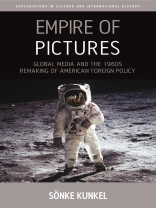In Cold War historiography, the 1960s are often described as a decade of mounting diplomatic tensions and international social unrest. At the same time, they were a period of global media revolution: communication satellites compressed time and space, television spread around the world, and images circulated through print media in expanding ways. Examining how U.S. policymakers exploited these changes, this book offers groundbreaking international research into the visual media battles that shaped America’s Cold War from West Germany and India to Tanzania and Argentina.
قائمة المحتويات
List of Figures
Preface
List of Abbreviations
Introduction: Why Empires Need Pictures
PART I: THE RISE OF THE VISUAL AGE
Chapter 1. The Picture State and Its Innovators
Chapter 2. Contact Points with Empire and the Globalizing of Media
PART II: PICTURING EMPIRE
Chapter 3. Prosperity: Official Visits to the United States
Chapter 4. Progress: Popular Aspirations, the Global South, and the Politics of Imagination
Chapter 5. Peace: Space Flights as “Pictorial Acts”
Chapter 6. Power: Global Media and the Other History of the Vietnam War
Conclusion: From Nixon to Obama, or: The Legacy of the 1960s
Endnotes
Bibliography
Index
عن المؤلف
Sönke Kunkel is Professor of North American History at the John F. Kennedy Institute for North American Studies at the Free University of Berlin. His publications include two edited volumes and numerous essays on U.S. foreign policy. He was research fellow at the universities of Oxford, Harvard, Ohio State, and Jacobs University Bremen.








